TYNWALD DAY.
I. TYNWALD MOUNT.
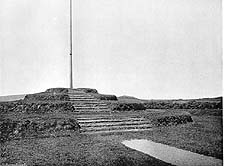 A
REMARKABLE custom is observed annually on Tynwald Mount, in
the Isle of Man, on old Midsummer Day, July 5th. Alike for antiquity,
quaintness, and as the only survival of the oral method of handing
down laws, it is very interesting, and though, of course, almost
superfluous, it should be continued, if only as a link with the days
of the Sagas.
A
REMARKABLE custom is observed annually on Tynwald Mount, in
the Isle of Man, on old Midsummer Day, July 5th. Alike for antiquity,
quaintness, and as the only survival of the oral method of handing
down laws, it is very interesting, and though, of course, almost
superfluous, it should be continued, if only as a link with the days
of the Sagas.
The principal part of the ceremony — proclaiming the laws
— takes place on Tynwald Hill, the name of which indicates its
ancient use. Tyn " is derived from the Icelandic word "Thingvellir,"
which means the place where a "Thing " — that is, a public
assembly — is held. "Thing," denoting an assembly, was in common
use in Anglo-Saxon times, and is still preserved in the Storthing, in
the kingdom of Norway. In Early English history, too, it appears in
such forms as "Althing," " Tything," " Thingstead," etc. "Tynwald,"
therefore, may be taken to mean the place of meeting of a public
governing body.
At one time proclaiming the laws was common among Norse nations,
and long survived in Iceland — the Tynwald Hill or Thingvellir
of which country, it may be noted, is also called the "Loberg,"
meaning Law Rock — though it has been discontinued. But only in
the Isle of Man is the custom now carried out.
II. CHURCH AND STATE.
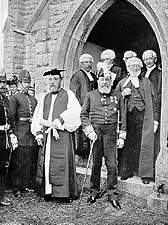 THE
proceedings on Tynwald Day begin with a gathering at the Chapel of
St. John, near the famous hill. Attended by a military escort, the
Governor (representing the King) goes to the chapel, and is there
received by the Bishop, Clergy, Keys, Deemsters, Coroners, and a
large number of people, many of them visitors from the mainland.
THE
proceedings on Tynwald Day begin with a gathering at the Chapel of
St. John, near the famous hill. Attended by a military escort, the
Governor (representing the King) goes to the chapel, and is there
received by the Bishop, Clergy, Keys, Deemsters, Coroners, and a
large number of people, many of them visitors from the mainland.
Of course, the presence of the Bishop and the Governor symbolises
the union of Church and State. These officials are together
throughout the whole ceremony, both on the hill and in the chapel
— a circumstance noteworthy in so great a stronghold of
Nonconformity as the Isle of Man.
III. SALUTING THE GOVERNOR.
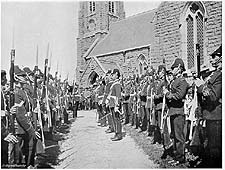 AFTER
Divine service in the chapel, a procession is formed and proceeds to
the hill. It goes through a company of Volunteers and a number of
Naval Reserve men from
Peel, drawn up on each side of the pathway; and the Governor,
before whom the Sword of State is carried, is saluted as he
passes.
AFTER
Divine service in the chapel, a procession is formed and proceeds to
the hill. It goes through a company of Volunteers and a number of
Naval Reserve men from
Peel, drawn up on each side of the pathway; and the Governor,
before whom the Sword of State is carried, is saluted as he
passes.
IV. PROCLAIMING THE LAWS.
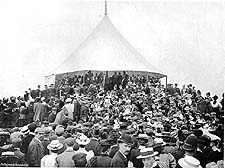 WHEN
the procession reaches the hill, the officials and Keys pass under a
tent — a modern innovation, the ceremony having taken place for
centuries with no canopy overhead save that of heaven — and the
people gather in crowds on the grass beyond. Then the Southern
Deemster calls upon the Coroner of Glenfaba to "fence the Court,"
which he does by " charging all present not to "quarrel, brawl, or
make any disturbance on pain of death."
WHEN
the procession reaches the hill, the officials and Keys pass under a
tent — a modern innovation, the ceremony having taken place for
centuries with no canopy overhead save that of heaven — and the
people gather in crowds on the grass beyond. Then the Southern
Deemster calls upon the Coroner of Glenfaba to "fence the Court,"
which he does by " charging all present not to "quarrel, brawl, or
make any disturbance on pain of death."
The proclamation is curious for its ancient phraseology, as are
all the forms used on the occasion, particularly the oath of the
Deemster. It runs :
"By this Book, and by the holy contents thereof, and by the
wonderful works that God hath miraculously wrought in heaven above
and in the earth beneath in six days and seven nights, I do swear
that I will, without respect or favour or friendship, love or gain,
consanguinity or affinity, envy or malice, execute the laws of this
isle justly between our Sovereign Lord the King and his subjects
within this isle, and betwixt party and party, as indifferently as
the herring's backbone doth lie in the midst of the fish."
As soon as the Court has been duly "fenced," the Coroners are
sworn in, after which the marginal notes of the laws are read, first
in English and then in Manx. This constitutes the proclamation of the
laws. An Act is not binding till so proclaimed, nor till then is it
an "Act of Tynwald." For many centuries it was necessary thus to make
the laws known, because no documentary record of them existed; but
now they are transmitted to paper in the usual way.
V. ST. JOHN'S CHAPEL.
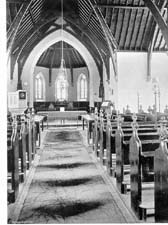 WITH
the reading of the laws the ceremony on the hill ends. The procession
is then re-formed, and the Court returns to the chapel, which, as
Durham Cathedral was "half church of God, half castle 'gainst the
Scot," may be described as half church of God, half Parliament house.
It passes up the rush-strewn aisle to two tables, at the head of each
of which is a chair, with seats down one side. The Bishop takes one
chair and the Governor the other, while the Keys distribute
themselves over the seats. If there be money votes they are then
quickly passed, after which the House rises. The business transacted
is always purely formal, any matter on which a debate may take place
being adjourned.
WITH
the reading of the laws the ceremony on the hill ends. The procession
is then re-formed, and the Court returns to the chapel, which, as
Durham Cathedral was "half church of God, half castle 'gainst the
Scot," may be described as half church of God, half Parliament house.
It passes up the rush-strewn aisle to two tables, at the head of each
of which is a chair, with seats down one side. The Bishop takes one
chair and the Governor the other, while the Keys distribute
themselves over the seats. If there be money votes they are then
quickly passed, after which the House rises. The business transacted
is always purely formal, any matter on which a debate may take place
being adjourned.
Whether the members of the Court, as they leave the building,
think of the rushes which they again tread under foot is, perhaps,
doubtful — unless, indeed, they commiserate the farmer who is
obliged to supply them for the occasion as a condition of his
tenancy. But these growths give the finishing touch of antiquity to
the whole proceedings, and prove to demonstration that they began in
the far-off days when carpets had still to be invented.
Notes
I have not yet determined the source of this essay, which I
obtained as a set of loose pages (numbered 46 et seq) taken
from an unknown larger work — each photograph has "Sir
Benjamin Stone's Neg" in the bottom lh corner. The Bishop shown is
Bishop Stratton 1892-1907, the Governor is Lord Henniker, 1895-1902;
thus making a date c.1900 most likely. Since writing this thanks to
Peter Kelly's notes on the same photograph reproduced from a copy in
the Manx Museum it is possible to date it to 5 July 1900. According
to Cubbon's Bibliography J.E.Leece
published c.1900 [not dated] Tynwald Day pp16
but the given dimensions 210x138 do not match the larger 290x235mm of
my copy.
(Behind the Bishop are Deemster Thomas Kneen, Samuel Harris (Vicar
General), Rev H.S.Gill and G.A.Ring (Attorney General))
For those curious about the wording of the Deemsters's Oath (the
six days and seven nights) it arises from the literal reading of the
bible in which the Lord first made night and day and on the seventh
day rested - i.e. starting from the first night there were 7 nights
and 6 days of Creation!
An acknowledgement in Curious Survivals by C. C. Williamson
[published 1924 London: Herbert Jenkins] is to 'the excellent
photographs taken by Sir Benjamin Stone, and deposited at the British
Museum and at the Corporation Gallery of Birmingham for the
advantages of students' — apparently containing several unique
representations of ancient customs. Another photograph presumeably
also dating from 1900 is reproduced below:
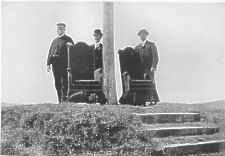
The Chairs set ready for the Governor and the Bishop
on the top of the Tynwald Hill.
 A
REMARKABLE custom is observed annually on Tynwald Mount, in
the Isle of Man, on old Midsummer Day, July 5th. Alike for antiquity,
quaintness, and as the only survival of the oral method of handing
down laws, it is very interesting, and though, of course, almost
superfluous, it should be continued, if only as a link with the days
of the Sagas.
A
REMARKABLE custom is observed annually on Tynwald Mount, in
the Isle of Man, on old Midsummer Day, July 5th. Alike for antiquity,
quaintness, and as the only survival of the oral method of handing
down laws, it is very interesting, and though, of course, almost
superfluous, it should be continued, if only as a link with the days
of the Sagas.
 AFTER
Divine service in the chapel, a procession is formed and proceeds to
the hill. It goes through a company of Volunteers and a number of
AFTER
Divine service in the chapel, a procession is formed and proceeds to
the hill. It goes through a company of Volunteers and a number of
 WHEN
the procession reaches the hill, the officials and Keys pass under a
tent — a modern innovation, the ceremony having taken place for
centuries with no canopy overhead save that of heaven — and the
people gather in crowds on the grass beyond. Then the Southern
Deemster calls upon the Coroner of Glenfaba to "fence the Court,"
which he does by " charging all present not to "quarrel, brawl, or
make any disturbance on pain of death."
WHEN
the procession reaches the hill, the officials and Keys pass under a
tent — a modern innovation, the ceremony having taken place for
centuries with no canopy overhead save that of heaven — and the
people gather in crowds on the grass beyond. Then the Southern
Deemster calls upon the Coroner of Glenfaba to "fence the Court,"
which he does by " charging all present not to "quarrel, brawl, or
make any disturbance on pain of death." WITH
the reading of the laws the ceremony on the hill ends. The procession
is then re-formed, and the Court returns to the chapel, which, as
Durham Cathedral was "half church of God, half castle 'gainst the
Scot," may be described as half church of God, half Parliament house.
It passes up the rush-strewn aisle to two tables, at the head of each
of which is a chair, with seats down one side. The Bishop takes one
chair and the Governor the other, while the Keys distribute
themselves over the seats. If there be money votes they are then
quickly passed, after which the House rises. The business transacted
is always purely formal, any matter on which a debate may take place
being adjourned.
WITH
the reading of the laws the ceremony on the hill ends. The procession
is then re-formed, and the Court returns to the chapel, which, as
Durham Cathedral was "half church of God, half castle 'gainst the
Scot," may be described as half church of God, half Parliament house.
It passes up the rush-strewn aisle to two tables, at the head of each
of which is a chair, with seats down one side. The Bishop takes one
chair and the Governor the other, while the Keys distribute
themselves over the seats. If there be money votes they are then
quickly passed, after which the House rises. The business transacted
is always purely formal, any matter on which a debate may take place
being adjourned.